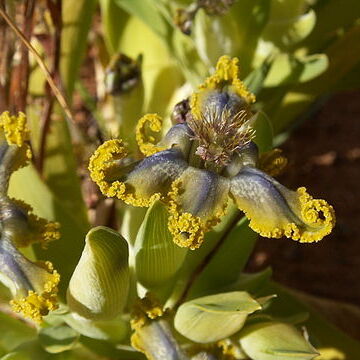Plants 90-200(-300) mm high. Stem either ± subterranean and few-branched at base, or stem produced above ground and branched from upper nodes. Leaves lanceolate, mostly 8-12 mm wide, sheaths usually concealing stem, usually prominently multi-veined without visible main vein, flat or lightly twisted, apex often hooked, margins thickened, hyaline, smooth, usually crisped and undulate at least proximally. Rhipidia 2-flowered; spathes green, usually with hooked tips, inner mostly 40-60 mm long, outer ± 1/2-2/3 as long as inner, usually entirely sheathing. Flowers on pedicels 12-20 mm long; usually pale to dark blue-violet, or light brown with blue speckling, margins crisped, dull yellow-green to khaki-coloured, with a narrow cup, 8-12 mm deep, ± 7 mm wide at rim, often unscented, lightly foetid-smelling, or scented of lemon and cinnamon, nectaries minute, at base of tepals; outer tepals 28-35 x 7-10 mm, limb at least 1.5 times as long as claw, and up to three times as long, often long-attenuate and coiled, claws 8-12 mm long; inner tepals 28-30 mm long, limbs reflexed, claws slender, 7-12 mm long. Filaments united in a column 7-11 mm long, free in upper ± 1.5 mm; anthers ± 3 mm long, ± half their length after dehiscence, thecae divergent. Ovary ellipsoid, 15-28 mm long, with beak 8-12 mm long; style branches ± 1.5 mm long, with diverging, prominently fringed arms, ± 1.5 mm long; stigmas on small lobes below tips of style arms and arching over anthers. Capsules 12-16 mm long, excluding beak. Seeds 3-4 mm long, dark brown, angular, 5-or 6-sided, surfaces slightly wrinkled.
More
Cormous geophyte, 10-40 cm. Leaves lanceolate, obtuse, in a tight fan, margins thickened and crisped. Flowers mostly blue to violet, sometimes creamy yellow speckled dark blue, tepal margins buff to light brown, tepal claws narrow, forming a deep cup, tips attenuate and coiled, anther lobes divergent, ovary beaked.

